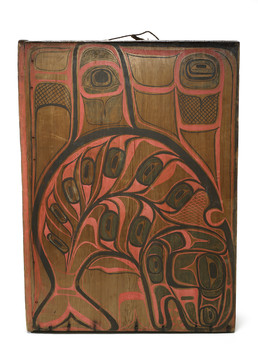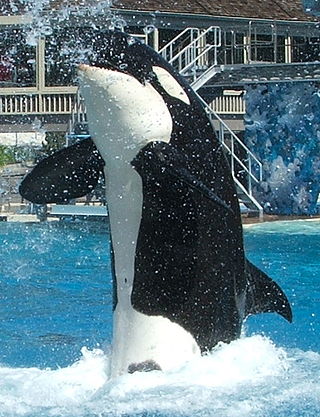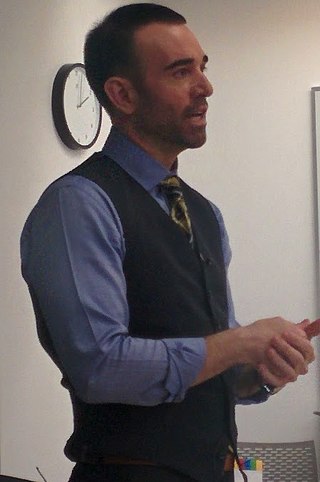Related Research Articles

A dolphin is an aquatic mammal within the infraorder Cetacea. Dolphin species belong to the families Delphinidae, Platanistidae, Iniidae, Pontoporiidae, and possibly extinct Lipotidae. There are 40 extant species named as dolphins.

The orca, or killer whale, is a toothed whale that is the largest member of the oceanic dolphin family. It is the only extant species in the genus Orcinus. Orcas are recognizable by their black-and-white patterned body. A cosmopolitan species, they are found in diverse marine environments, from Arctic to Antarctic regions to tropical seas.

The toothed whales are a parvorder of cetaceans that includes dolphins, porpoises, and all other whales possessing teeth, such as the beaked whales and sperm whales. 73 species of toothed whales are described. They are one of two living groups of cetaceans, the other being the baleen whales (Mysticeti), which have baleen instead of teeth. The two groups are thought to have diverged around 34 million years ago (mya).

SeaWorld is an American theme park chain with headquarters in Orlando, Florida. It is a proprietor of marine mammal parks, oceanariums, animal theme parks, and rehabilitation centers owned by United Parks & Resorts. The parks feature orcas, sea lion, and dolphin shows and zoological displays featuring various other marine animals.

Orca is a 1977 American thriller film directed by Michael Anderson and produced by Dino De Laurentiis, starring Richard Harris, Charlotte Rampling and Will Sampson. The film follows a male orca tracking down and getting revenge on a fishing boat and its captain for killing the whale's pregnant mate and their unborn calf.

Natsilane is the human hero of the "Blackfish" creation myth, one of the Tlingit and Haida stories about how the various supernatural animal species from the Tlingit culture of the American Northwest coast were created. These stories follow an almost dreamtime-like description of humans and other animal species living completely harmoniously. The animals are depicted as demi-gods, and are always referred to as proper singular nouns. There are other similar stories including how Raccoon got the rings on his tail and why Puma hides in the forest so much.

Dolphin drive hunting, also called dolphin drive fishing, is a method of hunting dolphins and occasionally other small cetaceans by driving them together with boats, usually into a bay or onto a beach. Their escape is prevented by closing off the route to the open sea or ocean with boats and nets. Dolphins are hunted this way in several places around the world including the Solomon Islands, the Faroe Islands, Peru, and Japan, which is the most well-known practitioner of the method. In large numbers dolphins are mostly hunted for their meat; some end up in dolphinariums.
Orcas are large, powerful aquatic apex predators. There have been multiple orca attacks on humans in the wild, but such attacks are less common than those by captive orcas. In captivity, there have been several non-fatal and four fatal attacks on humans since the 1970s. Experts are divided as to whether the injuries and deaths were accidental or deliberate attempts to cause harm.

Supersense is a six-part nature documentary television series produced by the BBC Natural History Unit, originally broadcast in the United Kingdom on BBC1 in 1988. The series producer was John Downer and the narrator Andrew Sachs. It used groundbreaking effects and filming techniques to show how animals perceive the world around them. The same production team went on to make the follow-up series Lifesense in 1991 and Supernatural: Unseen Power of Animals in 1999.

Dozens of orcas are held in captivity for breeding or performance purposes. The practice of capturing and displaying orcas in exhibitions began in the 1960s, and they soon became popular attractions at public aquariums and aquatic theme parks due to their intelligence, trainability, striking appearance, playfulness, and sheer size. As of 1 January 2024, around 59 orcas are in captivity worldwide, 35 of which were captive-born. At that time, there were 18 orcas in the SeaWorld parks.

Dawn Therese Brancheau was an American animal trainer at SeaWorld. She worked with orcas at SeaWorld Orlando for fifteen years, including a leading role in revamping the Shamu show, and was SeaWorld's poster girl. She was killed by an orca, Tilikum, who was also involved in the deaths of Keltie Byrne and Daniel P. Dukes.

Tilikum, nicknamed Tilly, was a captive male orca who spent most of his life at SeaWorld Orlando in Florida. He was captured in Iceland in 1983; about a year later, he was transferred to Sealand of the Pacific in Victoria, British Columbia. He was subsequently transferred in 1992 to SeaWorld in Orlando, Florida, where he sired 21 calves throughout his life.
The Undersea Adventures of Captain Nemo is a Canadian animated television series of five-minute cartoons produced in 1975 by Rainbow Animation in Toronto, Ontario. The series follows the underwater adventures of Captain Mark Nemo and his two young assistants, Christine and Robbie, in their nuclear-powered submarine, the Nautilus.

Blackfish is a 2013 American documentary film directed by Gabriela Cowperthwaite. It concerns Tilikum, an orca held by SeaWorld and the controversy over captive orcas. The film premiered at the 2013 Sundance Film Festival on January 19, 2013, and was picked up by Magnolia Pictures and CNN Films for wider release. It was nominated for the BAFTA Award for Best Documentary.

John Hargrove is a former senior killer whale trainer for SeaWorld and supervisor of killer whale training at Marineland of Antibes in France. Hargrove appeared in the 2013 documentary Blackfish, wrote a book about his experiences in Beneath the Surface, and has campaigned in support of legislation in California and New York to end the practice of keeping killer whales in captivity.

Gabriela Cowperthwaite is an American filmmaker. She has directed documentaries and feature films, and she also produces, edits, writes, and directs for television and documentary films. Her films often deal with social, cultural, and environmental issues relating to real life events. Her most notable film is Blackfish (2013), which received a BAFTA nomination for Best Documentary.
Port and Starboard are a pair of adult male orcas notable for preying on great white sharks off the coast of South Africa. The duo are identified as having rare and distinct collapsed dorsal fins and they are named for the nautical terms, as Port's fin collapses left and Starboard's collapses right. Port and Starboard are part of a distinctive "flat-toothed" ecotype present around South Africa.
References
- ↑ Day, Trevor (2007). Whalewatcher: a global guide to watching whales, dolphins and porpoises in the wild. Struik. p. 89. ISBN 978-1-77007-514-6 . Retrieved 10 September 2010.
- ↑ Gaius Plinius Secundus. Historia Naturalis 9.5.12 (Latin), in Bill Thayer's LacusCurtius: Into the Roman World . (See also an English translation by John Bostock and Henry Thomas Riley, 1855.) Retrieved February 19, 2010.
- 1 2 Joseph Andriano (1999). Immortal monster: the mythological evolution of the fantastic beast in modern fiction and film . Greenwood Publishing Group. pp. 28–32. ISBN 0-313-30667-2 . Retrieved 10 September 2010.
Orca movie.
- ↑ William F. Perrin; Bernd G. Würsig; J. G. M. Thewissen (2009). Encyclopedia of marine mammals. Academic Press. p. 908. ISBN 978-0-12-373553-9 . Retrieved 10 September 2010.
- ↑ The Whale (2011 film)
- ↑ Blackfish (film)
- ↑ "Grommo", Re: Killer Whale Lands On Kayak: Proof It's fake, YouTube, November 20, 2007. Retrieved 2010-02-19.
- ↑ "Kayak Attack." Snopes.com. Retrieved 2010-01-03.
- 1 2 Cronin, Brian (February 20, 2018). "The 15 Most Twisted Episodes Of G.I. Joe, No. 7: Iceberg Goes South". cbr.com.
- ↑ "Klee Wyck's Magic Quest". Archived from the original on 2011-06-06. Retrieved 2019-03-24.
- ↑ "Klee Wyck". Archived from the original on 2 June 2013. Retrieved 7 November 2012.